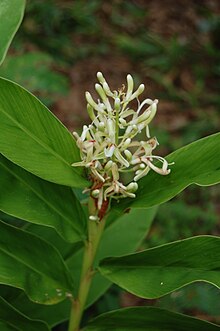Thai ginger
| Thai ginger | ||||||||||||
|---|---|---|---|---|---|---|---|---|---|---|---|---|

Thai ginger ( Alpinia galanga ) |
||||||||||||
| Systematics | ||||||||||||
|
||||||||||||
| Scientific name | ||||||||||||
| Alpinia galanga | ||||||||||||
| ( L. ) Willd. |
Thai ginger ( Alpinia galanga , syn .: Maranta galanga , Galanga officinalis Salisb. ) Is a species of the ginger family (Zingiberaceae). It serves as a spice and is an indispensable part of most spice pastes in Thai cuisine . The names are not very clear, so one sometimes speaks of Great Galangal or Galangawurzel , rarely also of " Alpinia ", in Indonesia of Langkuas or Laos, the Thai name is Kha ( ข่า ). It is one of four ginger-like plants known as galangal.
description
Alpinia galanga grows as a perennial herbaceous plant and reaches heights of about 2 meters. It forms bulbous rhizomes as persistence organs. Characteristic roots have yellowish-white leaf scars that are arranged in a ring around the rhizomes. The stalked leaves are 25 to 35 cm long and 6 to 10 cm wide.
Three to six flowers are formed per inflorescence . The hermaphrodite flowers are zygomorphic . The sepals and petals are each fused to form tubes and are 6 to 10 cm long. They bloom from May to August and fruit from September to November.
The oval capsule fruit is brown or reddish when ripe, 1 to 1.5 cm long, about 7 mm in diameter and contains three to six seeds.
The number of chromosomes is 2n = 48.
Occurrence
Thai ginger is originally found from southern China to Assam, Bangladesh, Thailand, Cambodia, Vietnam, Myanmar, Malaysia, Sumatra, Java, Borneo and the Philippines.
use

Only the yellowish, woody rhizome with the rose-colored side shoots is used from Thai ginger , as well as young stems. The “tuber” is peeled and then chopped up: for use in spice pastes it is pureed (see: Kaeng Khiao Wan ), for use in soups it is cut into slices (see, for example: Tom yam ). The taste is only vaguely reminiscent of ginger. It is sharp, pine resin-like and has a soapy component. The taste is brought about by essential oil and resins (galganol, alpinol).
The consumption of Thai ginger is said to have a beneficial effect on digestion. Therefore, one drinks the juice from a mixture of the grated root and lemon juice against stomach pain . Wraps with galangal powder can help against rashes. Galangal is also part of the herbal medicine Sweden bitter .
literature
- Anne Iburg (ed.): Dumonts little spice dictionary . 1st edition. Edition Dörfler in Nebel Verlag, Egolsheim 2004, ISBN 978-3-89555-202-1 .
Individual evidence
- ↑ a b Anne Iburg (ed.): Dumonts Kleines Gewürzlexikon , p. 34.
- ↑ Alpinia galanga at Tropicos.org. In: IPCN Chromosome Reports . Missouri Botanical Garden, St. Louis
- ↑ Rafaël Govaerts (ed.): Alpinia galanga. In: World Checklist of Selected Plant Families (WCSP) - The Board of Trustees of the Royal Botanic Gardens, Kew . Retrieved August 14, 2018.
- ^ Anne Iburg (Ed.): Dumonts Kleines Gewürzlexikon , p. 35.
Web links
- Galangal info page (Gernot Katzer)
- Galangal . In: Erowid . (English)
- The Plant List Alpinia galanga (L.) Willd., Synonyms
